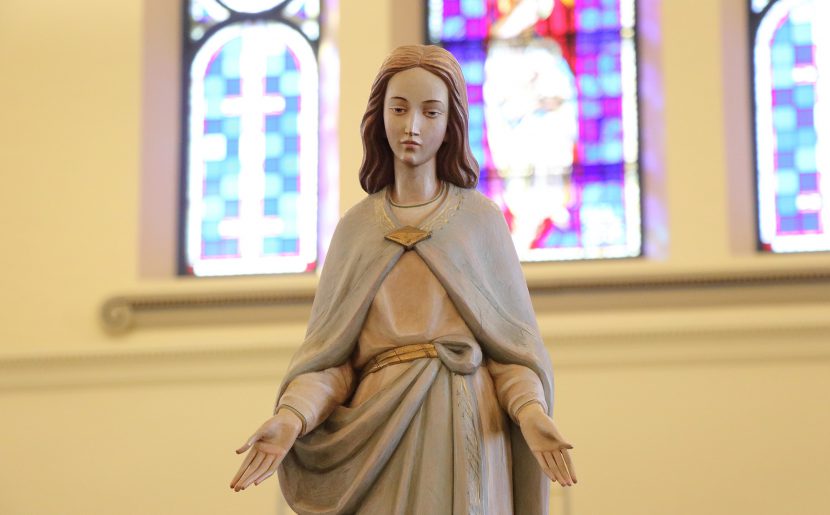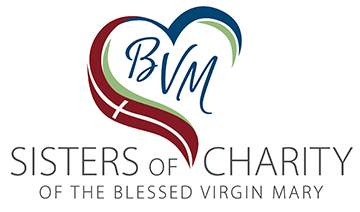The Immaculate Conception: A Reflection and Vow Renewal

Today we honor Mary as a woman who is unique, in the strict meaning of that word, not as we sometimes use it, meaning exceptional, outstanding, rare, unusual . . . Mary can actually be described by any one of those words, but more accurately, she is unique: conceived without flaw, without blemish, without imperfection, without sin . . . unlike any other person.
The essence of this feast (which was formally defined only about a century and a half ago) lies in the “doctrine of the Immaculate Conception,” which theologian Elizabeth Johnson says, “is a formulation of the tradition that God preserved Mary from the stain of original sin from the moment of her conception so that she would be worthy to bear the Son of God.”
There is a bit of both mystery and miracle in the reality described in this doctrine, which theologians, historians, and other scholars have discussed and debated in pages and pages of articles, books, and theses.
Along with other official documents relating to Mary, the Immaculate Conception doctrine has contributed to making her the subject of countless paintings, statues, stained glass windows, tapestries, poems, hymns, dramas, all of which takes her out of the realm of the everyday and places her on a pedestal at a high distance from most of us.
As one commentator says, she becomes a “mythologized” Mary.
Juxtaposed with these distant images of Mary, however, is the woman who, while still immaculately conceived, is also Mary of the small village community of Nazareth where she is daughter, cousin, mother, spouse, neighbor, companion, and friend, maybe the kind of generous caregiver, or volunteer that we think of with admiration today.
This is the Mary that I suspect many of us relate to more closely than to the ”Mystical Rose” or “Vessel of Honor,” describing her in the various invocations of the well-known Litany of the Blessed Virgin Mary.
This is the woman with whom we identify ourselves as Sisters of Charity of the Blessed Virgin Mary, and as Associates joined with us. She is not only in the formal title of our congregation but was, until relatively recently as we all know, also essential to each of our personal religious names. So significant was her name, that for a period of time when we ran out of ways to put Mary before another name, we added it afterward!
The fundamental reality is that Mary—the name, the woman, the mother of Jesus, the decision-maker, the next-door neighbor—is integral to our very identity.
She is at the core of who we are. Each of us is a Sister of Charity of the Blessed Virgin Mary. We and Mary are intertwined as BVMs.
Her Immaculate Conception is indeed unique, but in her everyday life, she offers us a less rarified companion and model of living. Although we BVMs are not literally mothers, many of our Associates could vouch for the challenges of having an infant son grow into a precocious young man. Some Associate parents also know the pain of a child’s death, even though not such a cruel death as Mary’s Son experienced.
For all of us, however, Mary is a model of acceptance. “Be it done unto me” are words she must have repeated in countless situations as she journeyed with her amazing Son from birth and childhood into adulthood, to the very end of His life in a tragic, painful death.
Dedication and trust are ever-present in her life as she copes with the unknown, with anxiety and uncertainty.
As we watch and wait in Advent-expectation to commemorate the birth of Jesus, we are reminded again of the fear that Mary must have experienced, not knowing where she and Joseph would find a place for the birthing. Tradition tells us that perhaps their only observers at the time were nearby shepherds, wise men from afar, and familiar animals. Trust that “all will be well” must have been absolutely crucial.
Even though our Scriptures and traditions give us only limited information about Mary of Nazareth, she serves as a model of several other qualities that inspire us to imitate her. She cares for her Son and for Joseph, of course, but also for her cousin Elizabeth and for villagers who run out of wedding wine.
She exhibits extraordinary courage in facing, among others, the challenges that accompany the role of mother of Jesus. Her humility and cooperation are emphasized by how little we actually know about this famous woman, with much of her life experience remaining in the background.
Her kindness and love are mostly implicit in the few scriptural stories in which she plays a significant role, as are the joy and peace which surely permeated her life.
In our desire to be more like this Mary of Nazareth and more intimately related to our loving God, on this feast-day we choose, as Sisters of Charity of the Blessed Virgin Mary, to renew our commitment:
to a vowed life of faithfulness to God,
faithfulness to one another in community,
faithfulness to God’s people, especially the poor.
In celebrating today’s particular feast of Mary Immaculate, which underscores her uniqueness, we are reminded that each of us is also unique in our own way, also marked by a bit of mystery and miracle.
I think of another feast when the angel says: “Hail Mary! . . . God is with you! . . . Blessed are you . . .”
God is with us as well. Blessed are we.

Philip Mary, you are gifting us again in our relationship with Mary and each other. You affirm our discoveries of Mary’s reality, wholeness and approachability, despite the limits of biblical sources. Thank you for this feast day reflection. which conveys a blessing for all of us.. Love, Robert Mary
You took the words right out of my mouth, Kathy! What a beautiful and timely reflection ♥️
Sara,
What a beautiful reflection! This was a controversial idea long before it became doctrine. The Franciscans and Dominicans battled over it. The Franciscans for, and the Dominicans against. But you, Sara, have presented it so simply and beautifully. Thank you!
A just-right reflection for me today: a meditative exploration of what it means to have “BVM” as part of my name. Thanks. Bertha Fox, BVM
Sara – former Phillip Mary – you are wonderful and gifted and a great neighbor. Can you believe us 65 years later?
Thank you, Sara, So grateful for your so appropriate thoughts. Peace. Betty
Thank you, Sara, your reflection reflects your scholarly skills and your sharing of BVM Marian love as well as your own love of Mary. Happy feastday !
Thank you, Sara, for your beautiful, inspiring words ❤ 🙏
Sara dear, Where have you been all these years? We should have had reflections from you all along for our feast days. Thank you for the depth of this reflection. Love,.
A powerful reflection, Sara. Thanks for sharing!
What more to say?-only deep gratitude. Thanks, Sara.
Dodie
Thanks, Sara, for such a comprehensive view of Mary. The sharing of the “doctrine- dogma” as part of the church history clarifies what has happened to the many understandings of her. Focusing on the Scriptural, historical context and devotional aspect, especially from a BVM perspective brings new life to Mary- Mary’s among us. So much in art, music, poetry, drama, past and present needs to be sifted and sorted. She is a woman of all women in her freedom, simplicity and feminine spirit. Marilyn
Sara, What a beautiful characterization of Mary! I often think of how Mary Frances Clarke mirrored her. And living where I live, I pray to be a similar example of at least some of her qualities. She is truly my model and my mother. Love, Miguel